Cell:
All living organisms on earth are formed of structural and functional units called cells. There are smaller pieces to cells that include biomolecules and organelles. There are also larger pieces called tissues and systems. Cells are small compartments that hold all of the biological equipment necessary to keep an organism alive and successful on earth. Cells come in many shapes and sizes.
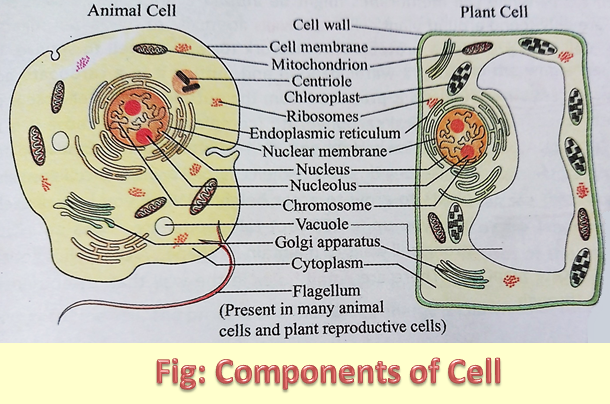
Components of Cell:
1. Cell membrane of Plasma membrane: The membrane enclosing a cell is made up of two lipid layers called a “bilipid” membrane. The fatty acid that makes up this membrane has two different parts a small water-loving head-hydrophilic head. Hydro stands for water and philic means liking or loving. The other part of this fatty acid is a long water-repelling or water-hating tail.
The cell membrane is not one solid piece. Everything in life is made of smaller pieces and a membrane is no different. Compounds called proteins and phospholipids make up most of the cell membrane. The proteins are found around the holes and help move molecules in and out of the cell.
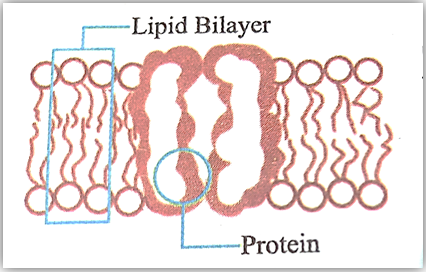
Scientists describe the organization of the phospholipids and proteins with the fluid mosaic model. The model shows that the phospholipids are in a shape like a head and a tail. The heads like water (hydrophilic) and the tails don’t like water (hydrophobic). The tails bump up against each other and the heads are out facing the watery area surrounding the cell. The two layers of cells are called the Bilayer.
2. Cell Wall: While cell membranes might be around every cell, cell walls made of cellulose are only found around plant cells. The Cell walls made of specialized sugars called cellulose. It provides a protected framework for a plant cell to survive. It’s like taking a water balloon and putting it in a cardboard box. The balloon protected from the outside world. Cellulose called a structural carbohydrate because it used in protection and support.
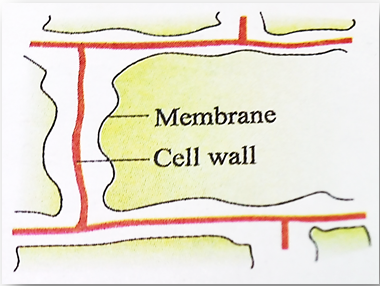
Cell walls also help a plant keep its shape. While they do protect the cells, cell walls, and cellulose also allow plants to grow to great heights. While you have a skeleton to hold you up, a 100-foot-tall deodar tree doesn’t. It uses strong cell walls to maintain its shape. A cell wall isn’t a fortress around the delicate plant cell. There are small holes in the wall that let nutrients, waste, and ions pass through.
3. Cytoplasm: Cytoplasm is the fluid that fills a cell. Scientists used to call the fluid protoplasm. It divided into cytoplasm and nucleoplasm. The cell organelles suspended in the cytosol. The cytoplasm has many different molecules dissolved in the solution. You’ll find enzymes, fatty acids, sugars, and amino acids that used to keep the cell working. Waste products also dissolved before they are taken in by vacuoles or sent out of the cell.
The cytoplasm is a thick solution that fills each cell and enclosed by the cell membrane. It composed of water, salts, and proteins. In eukaryotic cells, the cytoplasm includes all of the material inside the cell and outside of the nucleus.
4. Nucleus: The nucleus is the control center of the cell. It is the largest organelle in the cell and it contains the DNA of the cell. DNA (Deoxyribonucleic Acid) contains all the information for cells to live, perform their functions and reproduce. Not all cells have a nucleus. biology breaks cell types into eukaryotic and prokaryotic. If you don’t have a defined nucleus, your DNA is probably floating around the cell in a region called the nucleoid. A defined nucleus that holds the genetic code is an advanced feature in a cell.
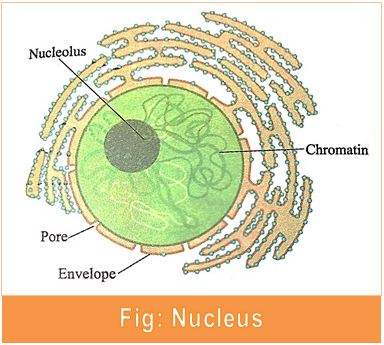
5. Mitochondria: Mitochondria are known as the powerhouses of the cell. They are organelles that act like a digestive system that takes in nutrients, breaks them down, and creates energy for the cell. The process of creating cell energy known as cellular respiration.
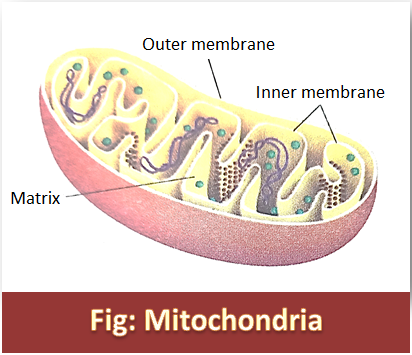
Most of the chemical reactions involved in cellular respiration happen in the mitochondria. A mitochondrion is shaped perfectly to maximize its efforts. It has two membranes. The outer membrane covers the organelle and contains it. The inner membrane folds over many times. That folding increases the surface area inside the organelle. Many of the chemical reactions happen on the inner membrane of the mitochondria. The increased surface area allows the small organelle to do as much work as possible. The fluid inside of the mitochondria is called the matrix.
6. Plastids: Plastids are the site of manufacture and storage of important chemical compounds used by the cell. Plastids often contain pigments used in photosynthesis and the types of pigments present can change or determine the cell’s color. The plastids are broadly classified into two main types namely chromoplasts and leucoplasts.
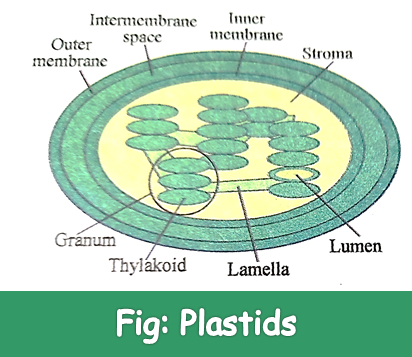
Chromoplasts are also divided into three types based on their color namely chloroplast (green), phaeoplast (dark brown), and rhodoplast (red). Leucoplasts are non-pigmented plastids. Their main function is to store food material. Chromoplasts are the food producers of the cell. They are only found in plant cells and some protists. Animal cells don’t have chloroplasts. Every green plant you see is working to convert the energy of the sun into sugars. They create sugars and the byproduct of that process is the oxygen that we breathe.
7. Endoplasmic Reticulum: Another important organelle in the cell is the endoplasmic reticulum (ER). The ER functions as a packaging system. It doesn’t work alone. The ER works closely with the Golgi apparatus, ribosome, RNA, etc. It creates a network of membranes found throughout the whole cell. There are two types of ER.
- Rough ER
- Smooth ER
Rough ER: It is also a very important organelle in the synthesis and packaging of proteins. When the protein is complete, the rough ER pinches off a vesicle. The vesicle is a small membrane bubble that can move to the cell membrane or the Golgi apparatus.

Smooth ER: It has its purpose in the cell. It acts as a storage organelle. It is important in the creation and storage of steroids.
8. Golgi Body of Golgi Apparatus or Golgi Complex: The Golgi Complex is found in most cells. It is another packaging organelle like the endoplasmic reticulum (ER) and also plays a profound role in secretion. It was named after Camillo Golgi, an Italian biologist.
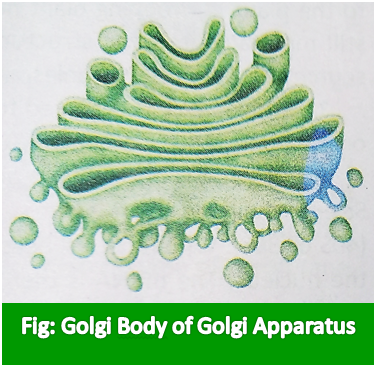
The Golgi complex gathers simple molecules and combines them to make molecules that are more complex. It then takes those big molecules, packages them in vesicles, and either stores them for later use or sends them out of the cell. The Golgi complex works closely with the rough ER.
9. Lysosome: You’ll find organelles called lysosomes in nearly every animal like eukaryotic cells. It holds enzymes that were created by the cell. The purpose of the lysosome is to digest things. They might be used to digest food or break down the cell when it dies.
10. Vacuole: Vacuoles are storage bubbles found in cells. They are found in both animal and plant cells but are much larger in plant cells. Vacuoles might store food or any variety of nutrients a cell might need to survive. They can even store waste products so the rest of the cell is protected from contamination. Eventually, those waste products would be sent out of the cell.

11. Ribosomes: Cells need to make proteins. Those proteins might be used as enzymes or as support for other cell functions. A ribosome is not just one piece. There are two pieces or subunits. Scientists named them larger subunits (the 60S or 50S) and smaller subunits (the 40S or 30S). When the cell needs to make protein, mRNA is created in the nucleus. The mRNA is then sent into the cell and the ribosomes.
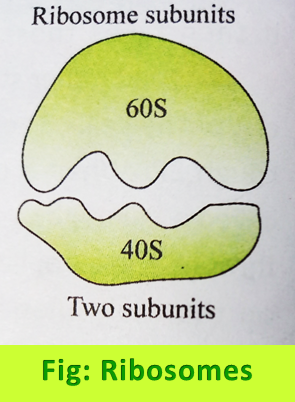
When it is time to make the protein, the two subunits come together and combine with the mRNA. The subunits lock onto the mRNA and start the protein synthesis. The 60S/40S model works fine for eukaryotic cells. Prokaryotic cells have ribosomes made of the 50S and 30S subunits.
12. Centriole: Every animal-like cell has two small organelles called centrioles. They are there to help the cell when it comes time to divide. You’ll usually find them near the nucleus but they can’t be seen when the cell isn’t dividing.
A centriole is a small set of microtubules arranged in a specific way. There are nine groups of microtubules. When two centrioles are found next to each other. They are usually at right angles. The centrioles are found in pairs and move toward the poles of the nucleus when it is time for cell division.
13. Microtubules: The cytoskeleton is made of various types of special proteins. Microtubules are hollow tubes made of globular proteins. Most notably, they are found in cilia, flagella, and centrioles. The arrangement of microtubules in cilia and flagella consists of nine doubles around the edge and two single microtubules in the center, all running the length of the structure. This is referred to as the “nine-plus-two formula“.